Environmental Life Cycle Assessment of Innovative Ejectors Plant Technology for Sediment By-Pass in Harbours and Ports
Abstract
1. Introduction
2. Materials and Methods
2.1. Ejectors Plant Demonstrator Description
2.2. LCA Methodology
2.2.1. Goal and Scope Definition
2.2.2. Life Cycle Inventory
2.2.3. Life Cycle Impact Assessment
2.3. Comparison between Maintenance Dredging and the Ejectors Plant
- While the effect of dredging on sediment removal can be measured in volume or mass (i.e., through bathymetries before and after dredging or direct measurements on the dredge), the effect of ejectors plant on sediment handling can only be estimated [33], since the sediment is continuously removed and transported away from the sedimentation area;
- While the ejectors plant can guarantee a certain water depth over time [33], maintenance dredging cannot.
2.3.1. Dredging Equipment Description
2.3.2. Literature Analysis of Environmental LCA of the Maintenance Dredging Operation
2.3.3. Definition of Maintenance Dredging Operations Able to Guarantee Navigability over the Year
- Time for dredging: 1 min to grab the sediment from the seabed and to discharge it on the hold, which means 100 min to fill in the hold;
- Time for reaching the disposal site and coming back: about 1 h;
- Time for sediment discharging: about 15 min.
- Dredging of 5000 m3 of sediment;
- Twelve days of propeller operation (6 h a day).
2.4. Summary of Study’s Assumptions and Limitations
2.5. Sensitivity Analysis
2.5.1. Electricity Mix
2.5.2. Ejectors Plant Lifetime
2.5.3. Ejectors Plant Maintenance
2.5.4. Maintenance Dredging Operation Working Cycle
3. Results
3.1. Ejectors Plant Inventory Analysis
3.1.1. Raw Materials Processing Inventory for the Construction Phase
3.1.2. Energy Inventory for the Operation Phase
3.1.3. Raw Materials Processing Inventory for the Operation Phase
3.2. Ejectors Plant Impacts Related to the Functional Unit
3.3. Ejectors Plant Category Indicator Calculation
3.4. Maintenance Dredging Plan Life Cycle Inventory and Life Cycle Impact Assessment
3.5. Sensitivity Analysis Results
3.5.1. Electricity Mix
3.5.2. Ejectors Plant Lifetime
3.5.3. Ejectors Plant Maintenance
3.5.4. Maintenance Dredging Operation Working Cycle
4. Discussion
4.1. Ejectors Plant Environmental Impact Analysis
4.2. Effect of Materials Selection on Ejectors Plant Environmental Impact
4.3. Comparison between Ejectors Plant and Dredging
4.4. Impact of Selected Parameters on Environmental LCA
4.4.1. Electricity Mix
4.4.2. Ejectors Plant Lifetime
4.4.3. Ejectors Plant Maintenance
4.4.4. Maintenance Dredging Operation Working Cycle
5. Conclusions and Future Development
Author Contributions
Funding
Institutional Review Board Statement
Informed Consent Statement
Data Availability Statement
Conflicts of Interest
References
- Tadros, M.; Ventura, M.; Guedes Soares, C. Review of current regulations, available technologies, and future trends in the green shipping industry. Ocean. Eng. 2023, 280, 114670. [Google Scholar] [CrossRef]
- Li, G.; Ren, Y.; Jiang, C.; Wang, W.; Guo, Y. Coordinated evolution game of marine supply chain from the perspective of sustainable development based on system dynamics. Ocean. Coast. Manag. 2024, 254, 107195. [Google Scholar] [CrossRef]
- Wang, J.; Zhang, B.; Dai, Q.; Kong, Y. Vertical structure selection and evolution in shipping supply chains under bilateral bargaining. Expert. Syst. Appl. 2024, 238, 122032. [Google Scholar] [CrossRef]
- Gavalas, D. Does sustainability reporting affect firm performance? Evidence from the port sector. Marit. Technol. Res. 2024, 6, 266092. [Google Scholar] [CrossRef]
- Zhang, Z.; Song, C.; Zhang, J.; Chen, Z.; Liu, M.; Aziz, F.; Kurniawan, T.A.; Yap, P.S. Digitalization and innovation in green ports: A review of current issues, contributions and the way forward in promoting sustainable ports and maritime logistics. Sci. Total Environ. 2024, 912, 169075. [Google Scholar] [CrossRef]
- Saha, R.C. Chattogram Port: A dedicated service institution to evolve the country boldly. Marit. Technol. Res. 2023, 5, 258294. [Google Scholar] [CrossRef]
- Okada, T.; Mito, Y.; Akiyama, Y.B.; Tokunaga, K.; Sugino, H.; Kubo, T.; Endo, T.; Otani, S.; Yamochi, S.; Kozuki, Y.; et al. Green port structures and their ecosystem services in highly urbanized Japanese bays. Coast. Eng. J. 2021, 63, 310–322. [Google Scholar] [CrossRef]
- Gerlitz, L.; Meyer, C. Small and medium-sized ports in the TEN-T network and nexus of Europe’s twin transition: The way towards sustainable and digital port service ecosystems. Sustainaibility 2021, 13, 4386. [Google Scholar] [CrossRef]
- Polrot, A.; Kirby, J.R.; Birkett, J.W.; Jenkinson, I.; Sharples, G.P. Steps towards the sustainable management of sediment in ports and harbours. In Towards Coastal Resilience and Sustainability, 1st ed.; Heidkamp, C.P., Morrissey, J., Eds.; Taylor & Francis Group: London, UK, 2018; Volume 16, pp. 258–271. [Google Scholar] [CrossRef]
- Wang, X.H.; Andutta, F.P. Sediment transport dynamics in ports, estuaries and other coastal environments. In Sediment Transport Processes and Their Modelling Applications, 1st ed.; Manning, A.J., Ed.; InTech: London, UK, 2013; Volume 1, pp. 1–34. [Google Scholar] [CrossRef]
- Saengsupavanich, C.; Yun, L.S.; Lee, L.H.; Sanitwong-Na-Ayutthaya, S. Intertidal intercepted sediment at jetties along the Gulf of Thailand. Front. Mar. Sci. 2022, 9, 970592. [Google Scholar] [CrossRef]
- Saengsupavanich, C.; Rif’atin, H.Q.; Magdalena, I.; Ariffin, E.H. A systematic review of jetty-induced downdrift coastal erosion management. Reg. Stud. Mar. Sci. 2024, 74, 103523. [Google Scholar] [CrossRef]
- European Sea Ports Organisation. ESPO Green Guide 2021—A Manual for European Ports towards a Green Future. 2021. Available online: https://www.espo.be/media/ESPO%20Green%20Guide%202021%20-%20FINAL.pdf (accessed on 10 June 2024).
- Sarma, K.G.S. Siltation and coastal erosion at shoreline harbours. Procedia Eng. 2015, 116, 12–19. [Google Scholar] [CrossRef]
- Bray, R.N.; Bates, A.D.; Land, J.M. Dredging—A Handbook for Engineers, 2nd ed.; Butterworth-Heinemann: Oxford, UK, 1996. [Google Scholar] [CrossRef]
- Newell, R.C.; Seiderer, L.J.; Hitchcock, D.R. The impact of dredging works in coastal waters: A review of the sensitivity to disturbance and subsequent recovery of biological resources on the sea bed. Oceanogr. Mar. Biol. 1998, 36, 127–178. [Google Scholar]
- Palmer, M.A.; Covich, A.P.; Lake, S.; Biro, P.; Brooks, J.J.; Cole, J.; Dahm, C.; Gibert, J.; Goedkoop, W.; Martnes, K.; et al. Linkages between aquatic sediment biota and life above sediments as potential drivers of biodiversity and ecological processes: A disruption or intensification of the direct and indirect chemical, physical, or biological interactions between aquatic sediment biota and biota living above the sediments may accelerate biodiversity loss and contribute to the degradation of aquatic and riparian habitats. BioScience 2000, 50, 1062–1075. [Google Scholar] [CrossRef]
- Torres, R.J.; Abessa, D.M.S.; Santos, F.C.; Maranho, L.A.; Davanso, M.B.; do Nascimento, M.R.L.; Mozeto, A.A. Effects of dredging operations on sediment quality: Contaminant mobilization in dredged sediments from the Port of Santos, SP, Brazil. J. Soils Sediments 2009, 9, 420–432. [Google Scholar] [CrossRef]
- Su, S.H.; Pearlman, L.C.; Rothrock, J.A.; Iannuzzi, T.J.; Finley, B.L. Potential long-term ecological impacts caused by disturbance of contaminated sediments: A case study. Environ. Manag. 2002, 29, 234–249. [Google Scholar] [CrossRef]
- Goncalves Castro, M.B.; Ooijens, S.; Van Ingen, L.W. Approaching emissions in dredging. Terra Aqua 2014, 137, 19–26. [Google Scholar]
- Mink, F.; Dirks, W.; Van Raalte, G.; De Vlieger, H.; Russell, M. Impact of European union environmental law on dredging. Terra Aqua 2006, 104, 3–10. [Google Scholar]
- Nicholson, S.; Szewczyk, E. Regulation and management of marine aggregate dredging in England. Terra Aqua 2022, 168, 28–37. [Google Scholar]
- Goncalves Castro, M.B.; Mestemaker, B.T.W.; Van Den Heuvel, H. Towards zero emission work vessels: The case of a dredging vessel. In Proceedings of the 2nd International Conference on Modelling and Optimisation of Ship Energy Systems (MOSES), Glasgow, UK, 8 May 2019. [Google Scholar]
- Ban, D.; Bebic, J. An introduction of future fuels on working ship for GHGs reduction: Trailing suction hopper dredger case study. J. Clean. Prod. 2023, 405, 137008. [Google Scholar] [CrossRef]
- Herman, P.M.J.; Simeon Moons, J.J.; Wijsman, J.W.M.; Luijendijk, A.P.; Ysebaert, T. A mega-nourishment (Sand Motor) affects landscape diversity of subtidal benthic fauna. Front. Mar. Sci. 2021, 8, 643674. [Google Scholar] [CrossRef]
- Bianchini, A.; Cento, F.; Guzzini, A.; Pellegrini, M.; Saccani, C. Sediment management in coastal infrastructures: Techno-economic and environmental impact assessment of alternative technologies to dredging. J. Environ. Manag. 2019, 15, 109332. [Google Scholar] [CrossRef]
- Memos, C.; Chiavaccini, P.; Dornhelm, R.; Hoekstra, R.; Inglis, P.; Sannasiraj, S.A.; Stoschek, O.; Willemsen, A.; Mink, E.; Sundar, V. Report n°130-2015 - Anti-Sedimentation Systems for Marinas and Yacht Harbours; PIANC Secrétariat Général: Bruxelles, Belgium, 2015; ISBN 978-2-87223-227-7. [Google Scholar]
- Kirichek, A.; Cronin, K.; de Wit, L.; van Kessel, T. Advances in maintenance of ports and waterways: Water injection dredging. In Sediment Transport—Recent Advances, 1st ed.; Wallingford, H.R., Ed.; InTech: London, UK, 2022; Volume 6, pp. 1–20. [Google Scholar] [CrossRef]
- Bruun, P. Navigation and sand bypassing at inlets: Technical management and cost aspects. J. Coast. Res. 1996, 23, 113–119. [Google Scholar]
- Pellegrini, M.; Guzzini, A.; Saccani, C. Techno-economic assessment of the innovative ejectors plant technology for sediment management in harbours. J. Soils Sediments 2022, 22, 2844–2852. [Google Scholar] [CrossRef]
- Mikac, B.; Abbiati, M.; Adda, M.; Colangelo, M.A.; Desiderato, A.; Pellegrini, M.; Saccani, C.; Turicchia, E.; Ponti, M. The environmental effects of the innovative ejectors plant technology for the eco-friendly sediment management in harbors. J. Mar. Sci. Eng. 2022, 10, 182. [Google Scholar] [CrossRef]
- Pellegrini, M.; Abbiati, M.; Bianchini, A.; Colangelo, M.A.; Guzzini, A.; Mikac, B.; Ponti, M.; Preda, G.; Saccani, C.; Willemsen, A. Sustainable sediment management in coastal infrastructures through an innovative technology: Preliminary results of the MARINAPLAN PLUS LIFE project. J. Soils Sediments 2020, 20, 2685–2696. [Google Scholar] [CrossRef]
- Pellegrini, M.; Aghakhani, A.; Gaeta, M.G.; Archetti, R.; Guzzini, A.; Saccani, C. Effectiveness assessment of an innovative ejector plant for port sediment management. J. Mar. Sci. Eng. 2021, 9, 197. [Google Scholar] [CrossRef]
- ISO 14040:2006; Environmental Management—Life Cycle Assessment—Principles and Framework. ISO: Geneva, Switzerland, 2006.
- ISO 14044:2006; Environmental Management—Life Cycle Assessment—Requirements and Guidelines. ISO: Geneva, Switzerland, 2006.
- Jocanovic, M.; Agarski, B.; Karanovic, V.; Orosnjak, M.; Ilic Micunovic, M.; Ostojic, G.; Stankovski, S. LCA/LCC model for evaluation of pump units in water distribution systems. Symmetry 2019, 11, 1181. [Google Scholar] [CrossRef]
- Islam, S.; Ponnambalan, S.G.; Lam, H.L. Review on life cycle inventory: Methods, examples and applications. J. Clean. Prod. 2016, 136, 266–278. [Google Scholar] [CrossRef]
- Erumban, A.A. Lifetimes of machinery and equipment: Evidence from Dutch manufacturing. Rev. Income Wealth 2008, 54, 237–268. [Google Scholar] [CrossRef]
- Nini, B.; Adne, C.; Terje, S.; Steinar, T.; Thom, A. Expected service lives and depreciation profiles for capital assets: Evidence based on a survey of Norwegian firms. J. Econ. Soc. Meas. 2016, 41, 329–369. [Google Scholar] [CrossRef]
- EC-JRC. ILCD Handbook: Recommendations for Life Cycle Impact Assessment in the European Context for the Choice of the Impact Categories; Publication Office of the European Commission: Luxemburg, 2011. [Google Scholar]
- EC-JRC. Characterisation Factors of the ILCD Recommended Life Cycle Impact Assessment Methods and EC-JRC; Publication Office of the European Commission: Luxemburg, 2012. [Google Scholar]
- JRC TR. Supporting Information to the Characterisation Factors of Recommended EF Life Cycle Impact Assessment Method for the Attribution of the Characterization Factors; European Commission, Ispra: Rome, Italy, 2018. [Google Scholar]
- Huijbregts, M.A.J.; Steinmann, Z.J.N.; Elshout, P.M.F.; Stam, G.; Verones, F.; Vieira, M.D.M. ReCiPe 2016—A Harmonized Life Cycle Impact Assessment Method at Midpoint and Endpoint Level—Report I: Characterization; National Institute for Public Health and the Environment, RIVM: Bilthoven, The Netherlands, 2016. [Google Scholar]
- Huijbregts, M.A.J.; Steinmann, Z.J.N.; Elshout, P.M.F.; Stam, G.; Verones, F.; Vieira, M.D.M.; Zijp, M.; Hollander, A.; van Zelm, R. ReCiPe2016: A harmonised life cycle impact assessment method at midpoint and endpoint level. Int. J. Life Cycle Assess. 2017, 22, 138–147. [Google Scholar] [CrossRef]
- Van Zelm, R.; Roy, P.O.; Hauschild, M.Z.; Huijbregts, M.A.J. Acidification. In Life Cycle Impact Assessment, 1st ed.; Hauschild, M., Huijbregts, M., Eds.; Springer: Dordrecht, the Netherlands; Berlin, Germany, 2015. [Google Scholar] [CrossRef]
- WHO. Health Risks of Particulate Matter from Long-Range Transboundary Air Pollution. 2006. Available online: https://iris.who.int/bitstream/handle/10665/107691/E88189.pdf?sequence=1 (accessed on 10 June 2024).
- Ferrans, L.; Nilsson, A.; Schmieder, F.; Pal, D.; Rahmati-Abkenar, M.; Marques, M.; Hogland, W. Life cycle assessment of management scenarios for dredged sediments: Environmental impacts caused during landfilling and soil conditioning. Sustainability 2022, 14, 13139. [Google Scholar] [CrossRef]
- Pasciucco, F.; Pecorini, I.; Di Gregorio, S.; Pilato, F.; Iannelli, R. Recovery strategies of contaminated marine sediments: A life cycle assessment. Sustainability 2021, 13, 8520. [Google Scholar] [CrossRef]
- Goncalves Castro, M.B.; Holtkamp, M.J.; Vercruijsse, P.M.; van der Blom, E.C.; van Woerden, D. Using life cycle analysis methodology to assess the sustainability of dredging equipment and its manufacturing processes. In Proceedings of the CEDA Dredging Days 2011: Dredging and Beyond, Rotterdam, the Netherlands, 10 November 2011. [Google Scholar]
- Murakami, S.; Oguchi, M.; Tasaki, T.; Daigo, I.; Hashimoto, S. Lifespan of commodities, Part I—The creation of a database and its review. J. Ind. Ecol. 2010, 14, 598–612. [Google Scholar] [CrossRef]
- Potrč Obrecht, T.; Jordan, S.; Legat, A.; Passer, A. The role of electricity mix and production efficiency improvements on greenhouse gas (GHG) emissions of building components and future refurbishment measures. Int. J. Life Cycle Assess. 2021, 26, 839–851. [Google Scholar] [CrossRef]
- Faria, R.; Marques, P.; Moura, P.; Freire, F.; Delgado, J.; de Almeida, A.T. Impact of the electricity mix and use profile in the life-cycle assessment of electric vehicles. Renew. Sust. Energ. Rev. 2013, 24, 271–287. [Google Scholar] [CrossRef]
- Available online: https://support.ecoinvent.org/ecoinvent-version-3.7.1 (accessed on 10 June 2024).
- IPPC. 2019 Refinement to the 2006 IPCC Guidelines for National Greenhouse Gas Inventories. 2019. Available online: https://www.ipcc.ch/report/2019-refinement-to-the-2006-ipcc-guidelines-for-national-greenhouse-gas-inventories/ (accessed on 10 June 2024).
- World Steel Association. Steel Statistical Yearbook 2019. 2019. Available online: http://srvcalidad.mincomercio.gov.co/Practicas-Comerciales/Mincomercio/ED-215-49-110_perfiles%20en%20LyU_publico_T10.pdf (accessed on 10 June 2024).
- Available online: https://ec.europa.eu/eurostat/statistics-explained/index.php?title=Air_pollution_statistics_-_emission_inventories (accessed on 10 June 2024).
- European Aluminium Association. Environmental Profile Report. 2018. Available online: https://european-aluminium.eu/wp-content/uploads/2023/01/European-Aluminium_Environmental-Profile-Report-2018_full-version.pdf (accessed on 10 June 2024).
- Terna. General Data. 2018. Available online: https://download.terna.it/terna/2018_Eng_1-GENERAL_DATA_8d8d35ce7ff3424.pdf (accessed on 10 June 2024).
- GSE. Complementary Energy Mix. 2021. Available online: https://www.gse.it/servizi-per-te/fonti-rinnovabili/fuel-mix/documenti (accessed on 10 June 2024).
- ISPRA. Italian Emission Inventory 1990–2021; Ispra: Rome, Italy, 2023. [Google Scholar]
- EMEP; EEA. EMEP/EEA Air Pollutant Emission Inventory Guidebook 2019—1.A.3.d.i, 1.A.3.d.ii, 1.A.4.c.iii; Publications Office of the European Union: Luxemburg, 2019. [Google Scholar]
- Paipa Sanabria, E.; Orozco-Lopez, M.B.; Escalante-Torres, F.; Camargo-Diaz, C.P.; Zapata-Cortes, J.A. Exploring the landscape of eco-innovation: A bibliometric analysis of concepts and trends in the manufacturing and shipbuilding industries. Sustainability 2024, 16, 5188. [Google Scholar] [CrossRef]
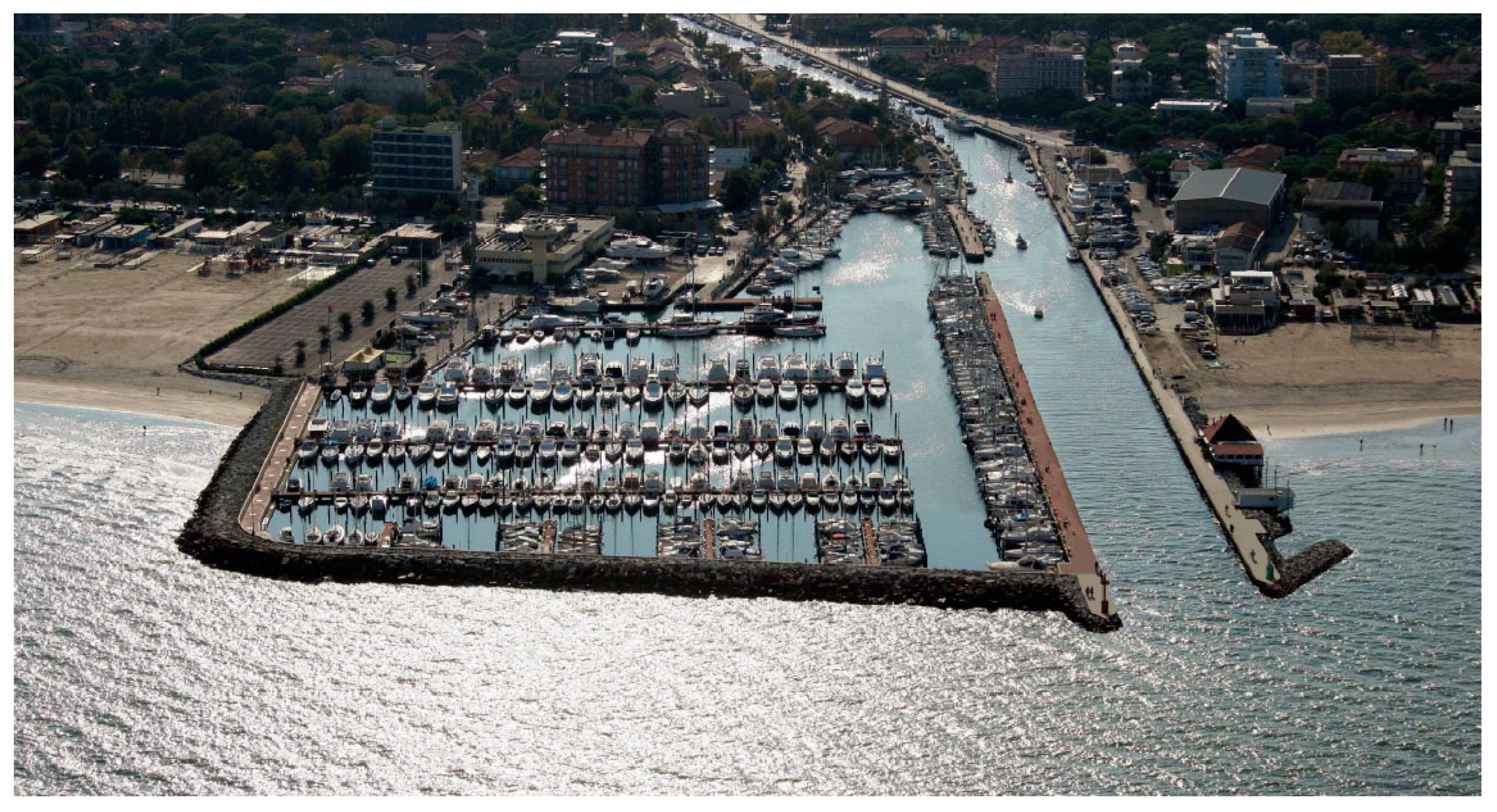

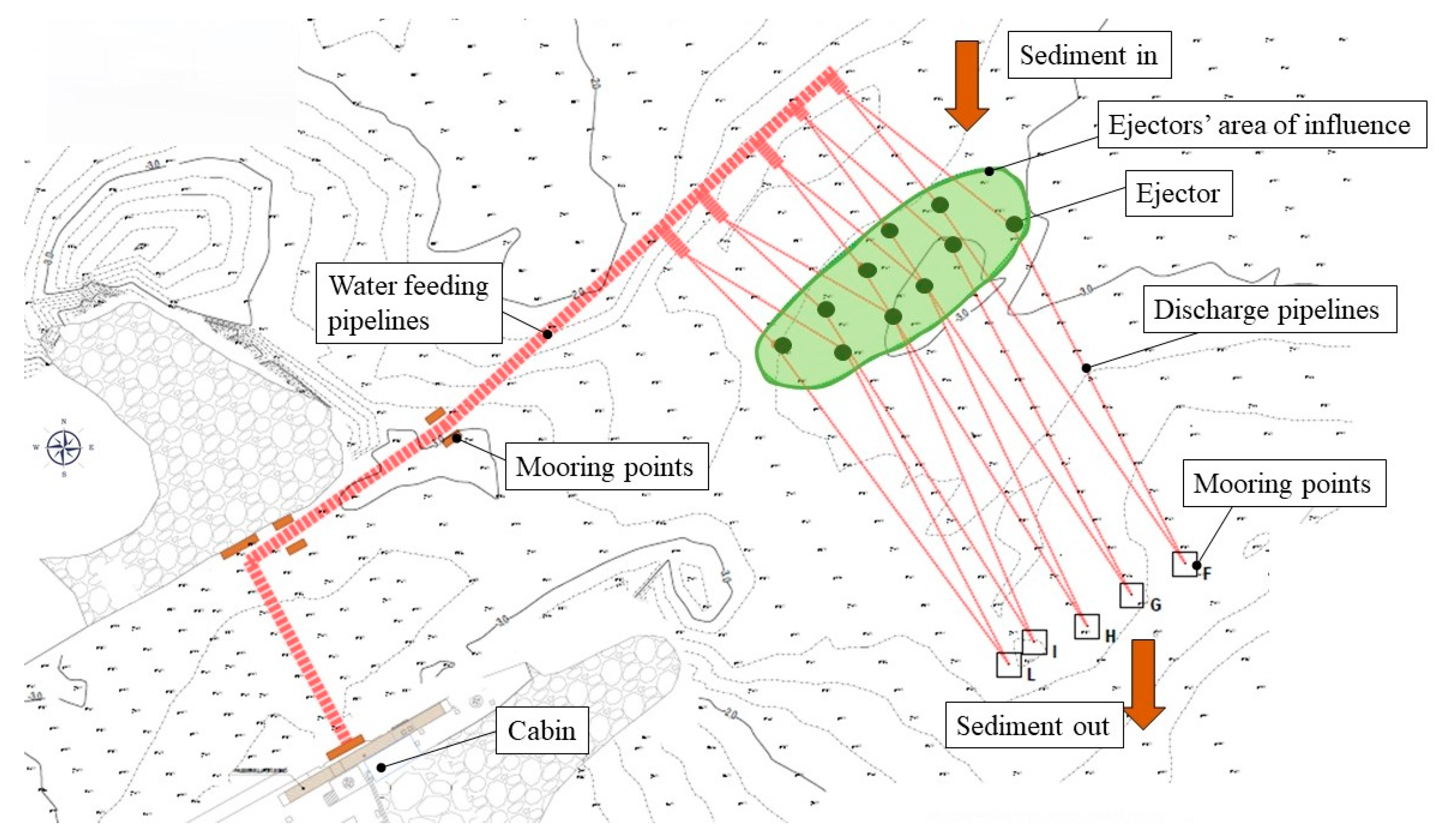



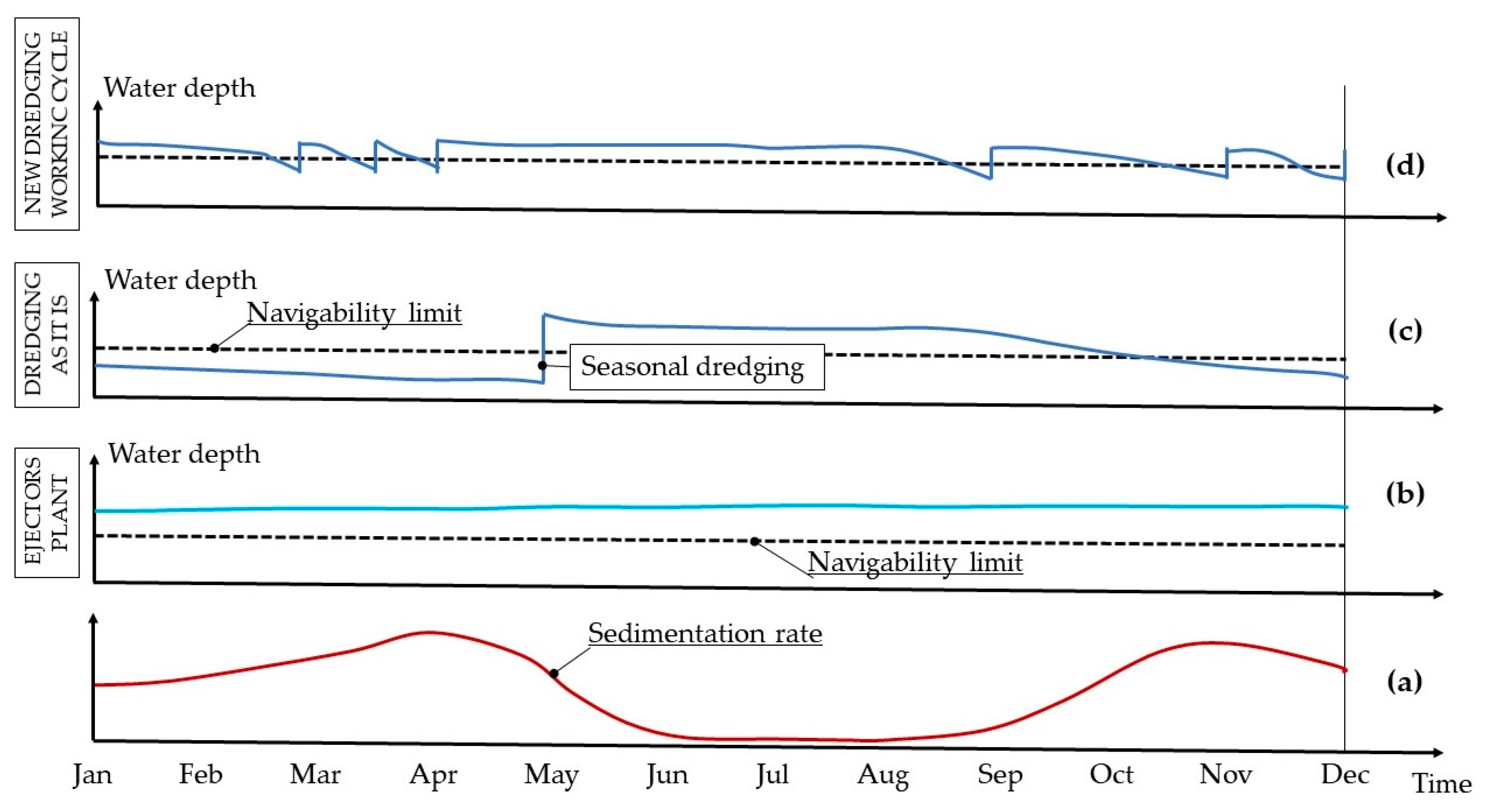
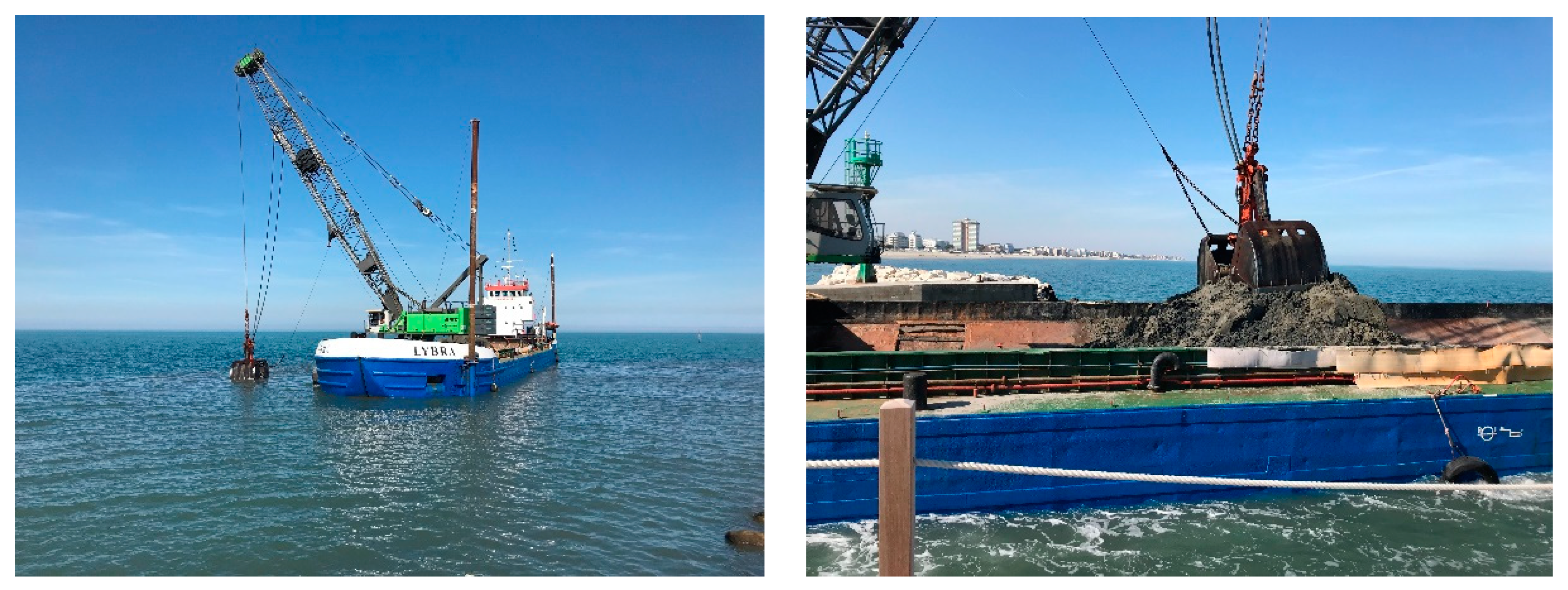


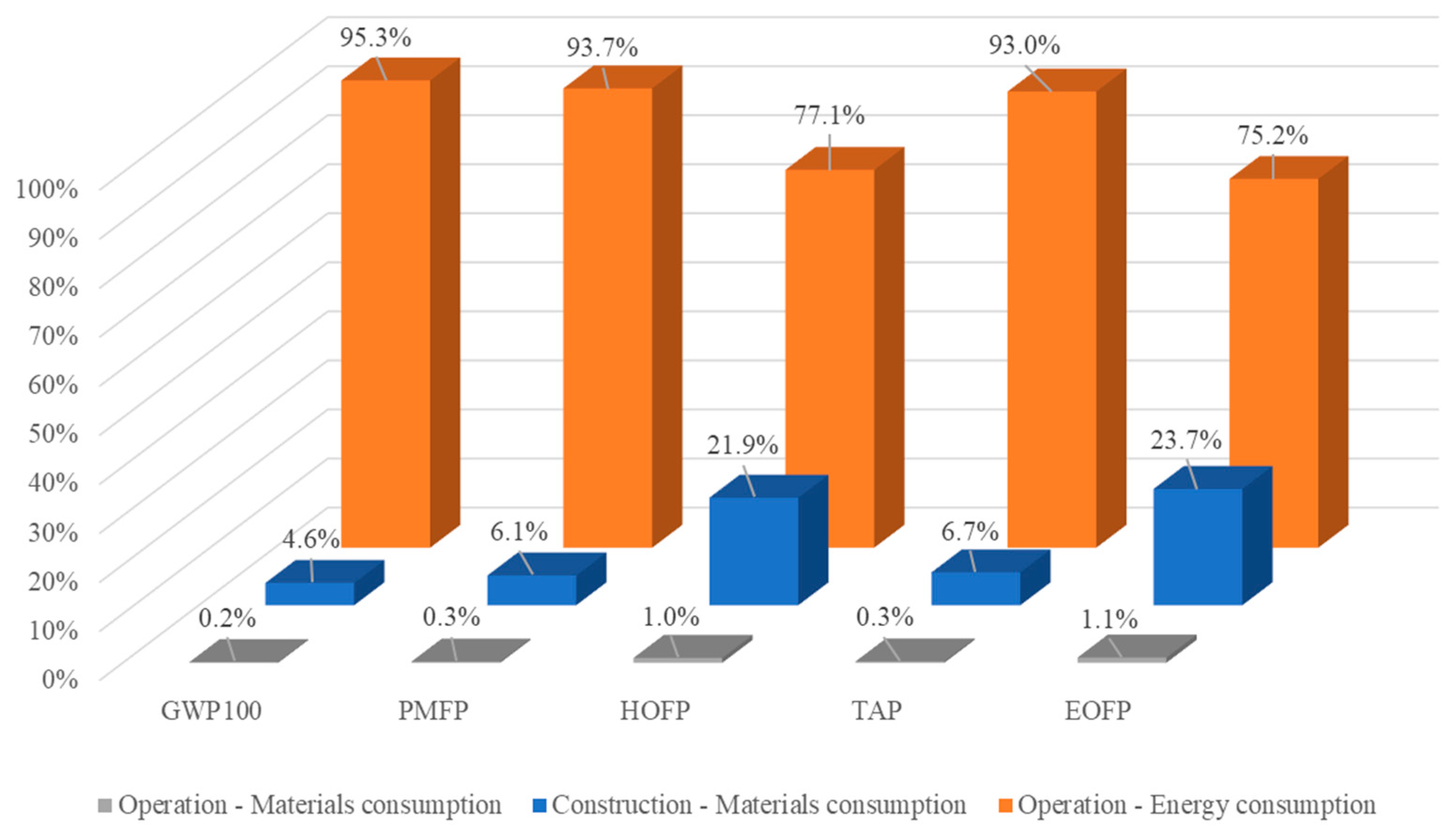
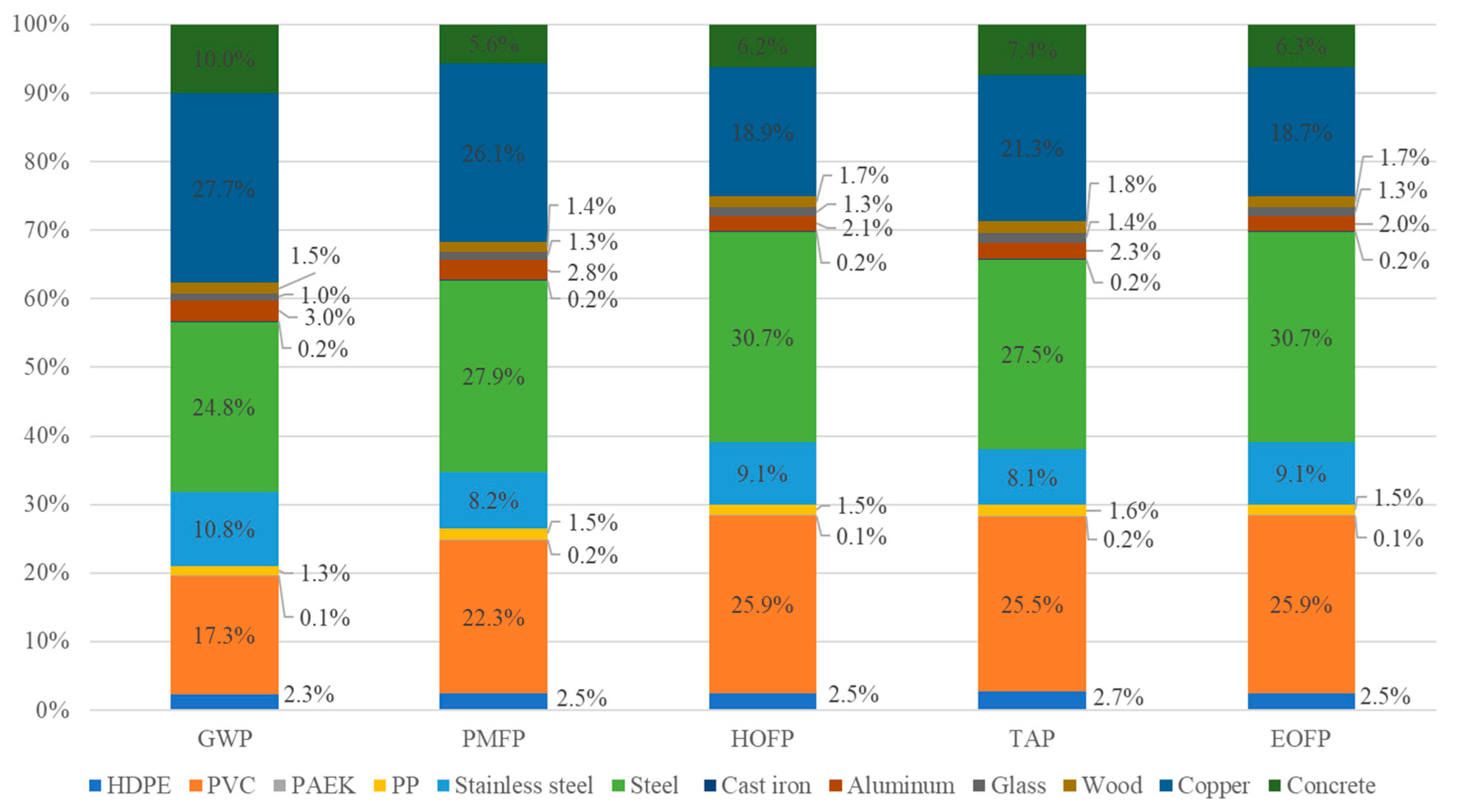



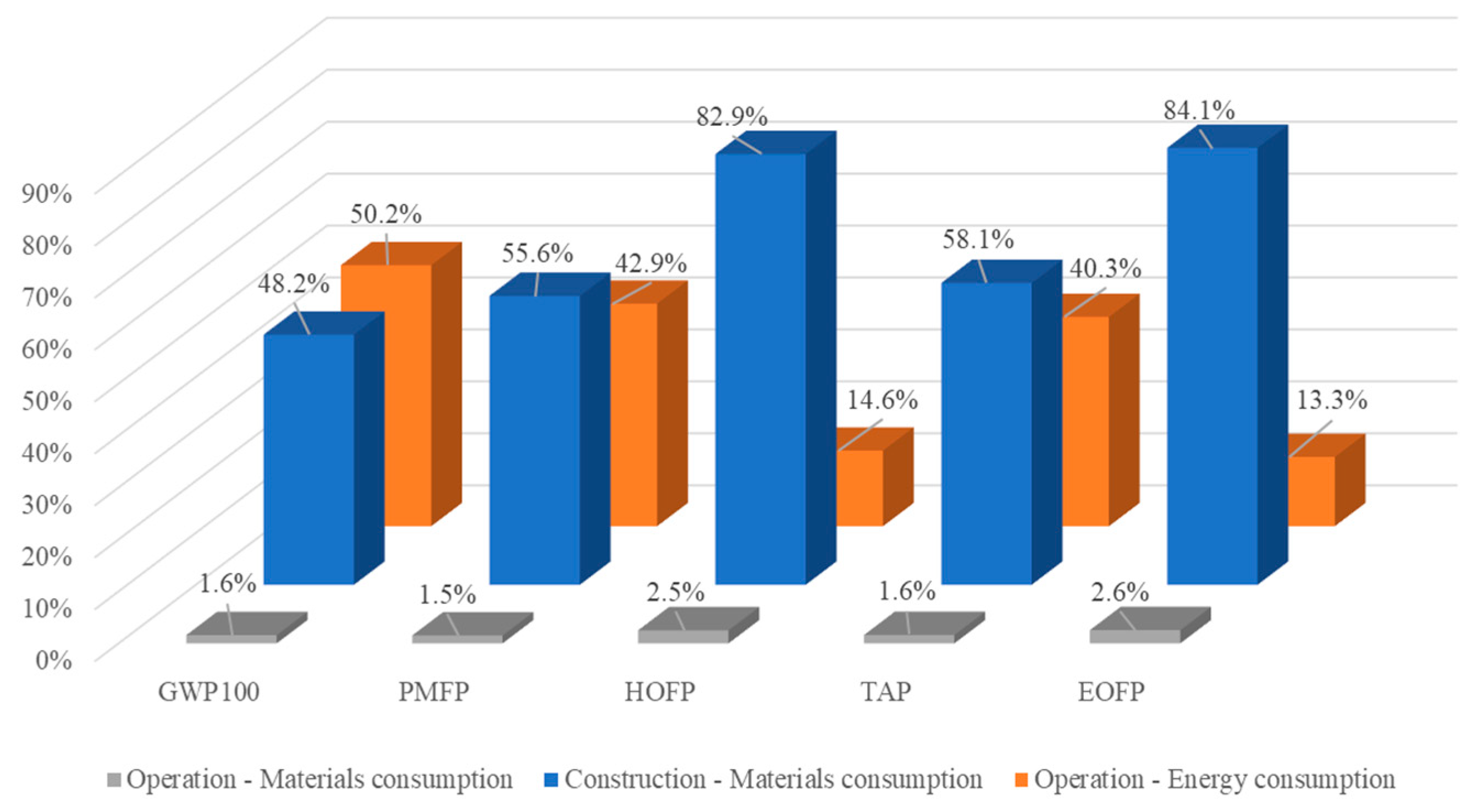
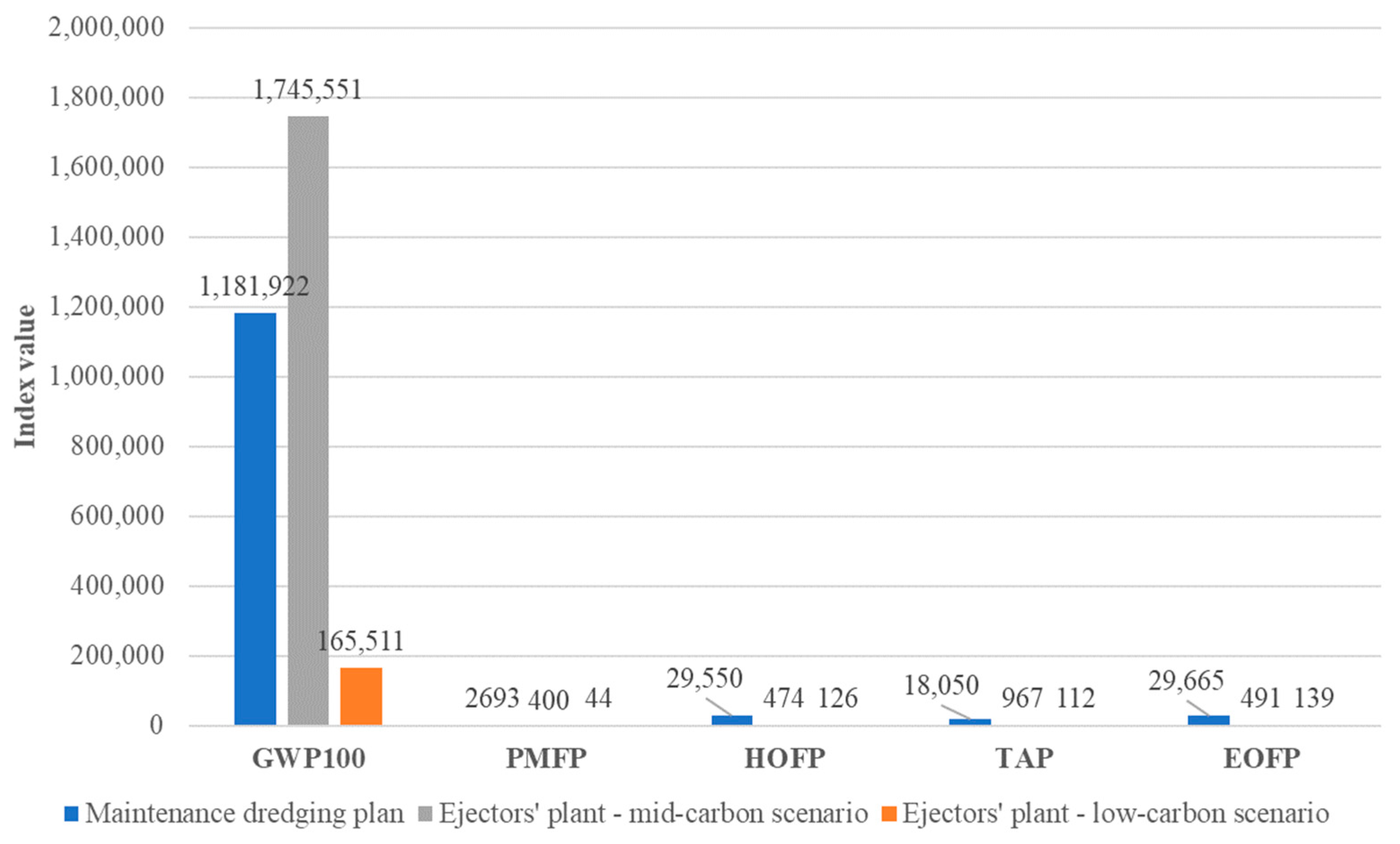
| Impact Category | Indicator | CFm | Abbr. | Unit |
|---|---|---|---|---|
| Climate change | Infra-red radiative forcing increase | Global warming potential | GWP | kg CO2 to air |
| Fine particulate matter formation | PM2.5 population intake increase | Particulate matter formation potential | PMFP | kg PM2.5 to air |
| Photochemical oxidant formation: ecosystem quality | Photochemical oxidant formation: ecosystem quality | Photochemical oxidant formation potential: ecosystems | EOFP | kg NOx to air |
| Photochemical oxidant formation: human health | Tropospheric ozone population intake increase (M6M) | Photochemical oxidant formation potential: humans | HOFP | kg NOx to air |
| Terrestrial acidification | Proton increase in natural soils | Terrestrial acidification potential | TAP | kg SO2 to air |
| Area of Protection | Endpoint | Abbr. | Name | Unit |
|---|---|---|---|---|
| Human health | Damage to human health | HH | Disability-adjusted loss of life years | year |
| Natural environment | Damage to ecosystem quality | ED | Time-integrated species loss | species·yr |
| Resource scarcity | Damage to resource availability | RA | Surplus cost | Euro |
| Impact | Emissions |
|---|---|
| Climate Change | CO2 |
| Terrestrial Acidification | NOx |
| SOx | |
| Fine Particulate Matter Formation | PM2.5 |
| SOx | |
| Photochemical Oxidant Formation | NOx |
| NMVOC |
| Item | Characteristics | Mean Diesel Consumption |
|---|---|---|
| N°2 propeller engines | 381 Hp (284 kW) each | 117.8 L/h each |
| N°1 grab crane engine | 291 Hp (217 kW) | 31.5 L/h |
| N°4 pumps | 6000 L/min, 75 kW each | 14.2 L/h each |
| Grab capacity | 3 m3 | - |
| Hold | 300 m3 | - |
| Speed | 16.7 km/h (9 knots) | - |
| Assumption | References |
|---|---|
| Components manufacturing, transport and assembly are neglected in the ejectors plant environmental LCA and comparison with maintenance dredging. | [36,49] |
| Ejectors plant has a lifetime of 20 years | [38,47] |
| Inverters, pumps and brackets have a lifetime of 10 years | [38,39] |
| Substitution of 5 m per year of underwater pipeline | [30] |
| Ejector plant yearly energy consumption of 252,000 kWh | [30] |
| Definition of a dredging working cycle able to guarantee navigability over the year | [30,33] |
| Materials | Weight (kg) | Weight (%) |
|---|---|---|
| High-density polyethylene (HDPE) | 1016.2 | 2.9 |
| Polyvinyl chloride (PVC) | 7242.2 | 20.7 |
| Polyaryletherketone (PAEK) | 44.3 | 0.1 |
| Polypropylene (PP) | 620.1 | 1.8 |
| Stainless steel (AISI 316) | 1268.3 | 3.6 |
| Steel | 8588.9 | 24.6 |
| Cast iron | 63.5 | 0.2 |
| Aluminium | 217.9 | 0.6 |
| Glass | 528.0 | 1.5 |
| Wood | 1360.0 | 3.9 |
| Copper | 4007.8 | 11.5 |
| Concrete | 10,000.0 | 28.6 |
| Total weight | 34,957.1 | 100.0 |
| Materials | CO2 | SOX | NOx | PM2.5 | NMVOC | References |
|---|---|---|---|---|---|---|
| HDPE | 1.8 | 0.001 | 0.002 | 0.0003 | 0.003 | [53] |
| PVC | 1.9 | 0.0012 | 0.003 | 0.0004 | 0.004 | [53,54] |
| PAEK | 2.2 | 0.0014 | 0.0025 | 0.0005 | 0.0035 | [53] |
| PP | 1.7 | 0.001 | 0.002 | 0.0003 | 0.003 | [53] |
| Stainless steel | 6.8 | 0.002 | 0.006 | 0.001 | 0.008 | [55] |
| Steel | 2.3 | 0.001 | 0.003 | 0.0005 | 0.004 | [55] |
| Cast iron | 2.1 | 0.001 | 0.0028 | 0.0004 | 0.0038 | [53,56] |
| Aluminium | 11.0 | 0.004 | 0.008 | 0.002 | 0.010 | [57] |
| Glass | 1.5 | 0.001 | 0.002 | 0.0003 | 0.003 | [53,54] |
| Wood | 0.9 | 0.0005 | 0.001 | 0.0001 | 0.0015 | [53,54] |
| Copper | 5.5 | 0.002 | 0.004 | 0.001 | 0.005 | [56] |
| Concrete | 0.8 | 0.0003 | 0.0005 | 0.0005 | 0.0008 | [53,54] |
| CO2 | SO2 | NOx | PM2.5 | NMVOC |
|---|---|---|---|---|
| 330 | 0.1018 | 0.0475 | 0.0200 | 0.0046 |
| Materials | Weight (kg) | Weight (%) |
|---|---|---|
| PVC | 169.5 | 33.1 |
| Stainless steel | 336.4 | 65.7 |
| Copper | 6.0 | 1.2 |
| Total weight | 511.9 | 100.0 |
| Boundary | Source | CO2 (kg) | SO2 (kg) | NOx (kg) | PM2.5 (kg) | NMVOC (kg) |
|---|---|---|---|---|---|---|
| Construction | Materials | 79,708 | 34.7 | 83.9 | 14.2 | 112.6 |
| Operation | Energy | 1,663,200 | 513.2 | 239.5 | 100.7 | 23.3 |
| Materials | 2643 | 0.9 | 2.6 | 0.4 | 3.4 | |
| Total | 1,745,551 | 548.8 | 325.9 | 115.3 | 139.3 | |
| Impact Categories | Characterisation Factor | Measuring Unit | Value |
|---|---|---|---|
| Climate change | GWP100 | kg CO2 to air | 1,745,551 |
| Terrestrial acidification | TAP | kg SO2 to air | 666.1 |
| Fine particulate matter formation | PMFP | kg PM2.5 to air | 274.5 |
| Photochemical oxidant formation: Human health | HOFP | kg NOx to air | 351.0 |
| Photochemical oxidant formation: ecosystem quality | EOFP | kg NOx to air | 366.3 |
| Impact Categories | Area of Protection | Measuring Unit | Value |
|---|---|---|---|
| Climate change | HH-DALY | years | 1.62 |
| ED-PDF | species·year | 0.005 | |
| Terrestrial acidification | ED-PDF | species·year | 0.0001 |
| Fine particulate matter formation | HH-DALY | years | 0.173 |
| Photochemical oxidant formation: Human health | HH-DALY | years | 0.0003 |
| Photochemical oxidant formation: ecosystem quality | ED-PDF | species·year | 0.00005 |
| Emission Factor (kg/ton) | ||||
|---|---|---|---|---|
| CO2 | SO2 | NOx | PM2.5 | NMVOC |
| 3160 | 20 | 78.5 | 1.4 | 2.8 |
| Impact Categories | Characterisation Factor | Measuring Unit | Value |
|---|---|---|---|
| Climate change | GWP100 | kg CO2 to air | 1,181,922 |
| Terrestrial acidification | TAP | kg SO2 to air | 18,050 |
| Fine particulate matter formation | PMFP | kg PM2.5 to air | 2693 |
| Photochemical oxidant formation: Human health | HOFP | kg NOx to air | 29,550 |
| Photochemical oxidant formation: Ecosystem quality | EOFP | kg NOx to air | 29,665 |
| Impact Categories | Area of Protection | Measuring Unit | Value |
|---|---|---|---|
| Climate change | HH-DALY | years | 1.10 |
| ED-PDF | species·year | 0.0033 | |
| Terrestrial acidification | ED-PDF | species·year | 0.0038 |
| Fine particulate matter formation | HH-DALY | years | 1.697 |
| Photochemical oxidant formation: Human health | HH-DALY | years | 0.027 |
| Photochemical oxidant formation: Ecosystem quality | ED-PDF | species·year | 0.0039 |
| Impact Categories | Characterisation Factor | Measuring Unit | Value |
|---|---|---|---|
| Climate change | GWP100 | kg CO2 to air | 165,511 |
| Terrestrial acidification | TAP | kg SO2 to air | 96.6 |
| Fine particulate matter formation | PMFP | kg PM2.5 to air | 37.4 |
| Photochemical oxidant formation: Human health | HOFP | kg NOx to air | 119.5 |
| Photochemical oxidant formation: Ecosystem quality | EOFP | kg NOx to air | 132.4 |
Disclaimer/Publisher’s Note: The statements, opinions and data contained in all publications are solely those of the individual author(s) and contributor(s) and not of MDPI and/or the editor(s). MDPI and/or the editor(s) disclaim responsibility for any injury to people or property resulting from any ideas, methods, instructions or products referred to in the content. |
© 2024 by the authors. Licensee MDPI, Basel, Switzerland. This article is an open access article distributed under the terms and conditions of the Creative Commons Attribution (CC BY) license (https://creativecommons.org/licenses/by/4.0/).
Share and Cite
Pellegrini, M.; Saccani, C.; Guzzini, A. Environmental Life Cycle Assessment of Innovative Ejectors Plant Technology for Sediment By-Pass in Harbours and Ports. Sustainability 2024, 16, 7809. https://doi.org/10.3390/su16177809
Pellegrini M, Saccani C, Guzzini A. Environmental Life Cycle Assessment of Innovative Ejectors Plant Technology for Sediment By-Pass in Harbours and Ports. Sustainability. 2024; 16(17):7809. https://doi.org/10.3390/su16177809
Chicago/Turabian StylePellegrini, Marco, Cesare Saccani, and Alessandro Guzzini. 2024. "Environmental Life Cycle Assessment of Innovative Ejectors Plant Technology for Sediment By-Pass in Harbours and Ports" Sustainability 16, no. 17: 7809. https://doi.org/10.3390/su16177809
APA StylePellegrini, M., Saccani, C., & Guzzini, A. (2024). Environmental Life Cycle Assessment of Innovative Ejectors Plant Technology for Sediment By-Pass in Harbours and Ports. Sustainability, 16(17), 7809. https://doi.org/10.3390/su16177809









